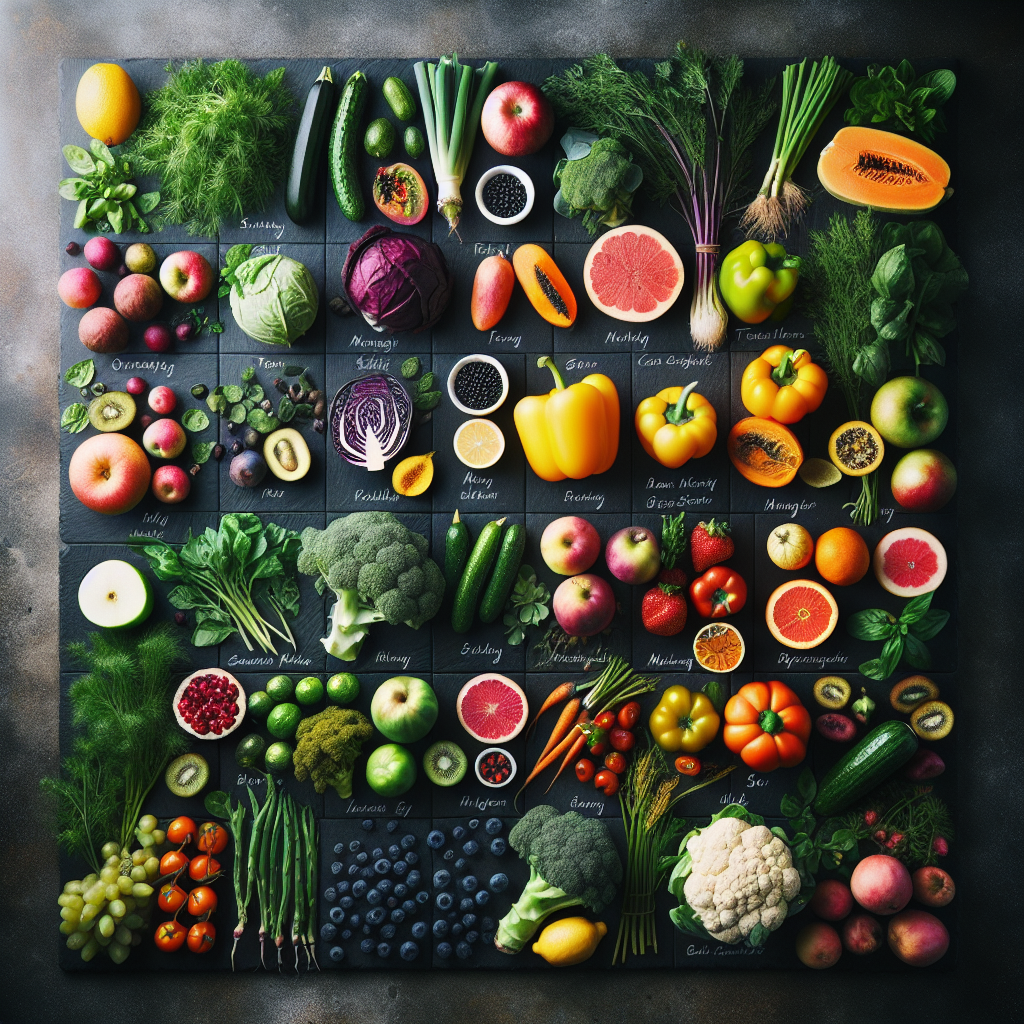Why Seasonal Organic Eating Matters
Eating organic food in season is one of the best ways to maximize nutrition, support local farmers, and reduce environmental impact. Seasonal produce is harvested at peak ripeness, ensuring higher vitamin and mineral content. Organic farming practices eliminate harmful pesticides, making your meals cleaner and healthier. By aligning your diet with nature’s calendar, you also enjoy fresher flavors while reducing the carbon footprint associated with long-distance food transportation.
Month-by-Month Guide to Organic Seasonal Eating
Here’s a practical breakdown of the best organic produce to enjoy each month, along with meal ideas to incorporate them into your diet.
January
Winter is in full swing, and root vegetables shine during this time. Some of the best organic picks include:
- Root Vegetables: Carrots, beets, parsnips, and turnips.
- Leafy Greens: Kale, Swiss chard, and collard greens.
- Citrus Fruits: Oranges, grapefruits, and lemons.
Try a roasted root vegetable medley or a citrus-kale salad for a nutrient-packed meal.
February
Cold-weather crops continue to dominate. Focus on:
- Cabbage & Brussels Sprouts: Great for stir-fries and roasted dishes.
- Winter Squash: Butternut and acorn squash for soups and stews.
- Apples & Pears: Perfect for baking or eating fresh.
A warm bowl of butternut squash soup with a side of roasted Brussels sprouts makes a comforting February meal.
March
As winter transitions to spring, look for early greens and lingering winter produce:
- Spinach & Arugula: Ideal for fresh salads.
- Leeks & Green Garlic: Adds depth to soups and sautés.
- Radishes: A crunchy addition to salads.
A spinach and radish salad with a lemon vinaigrette celebrates early spring flavors.
April
Spring is in full bloom, bringing tender greens and fresh herbs:
- Asparagus: Perfect for roasting or steaming.
- Peas: Fresh snap peas and sugar peas for stir-fries.
- Strawberries: Early-season berries for desserts or smoothies.
Grilled asparagus with a pea and mint puree makes a vibrant April dish.
May
Warmer weather brings more variety:
- Artichokes: Steamed or grilled for a Mediterranean touch.
- Cherries: Sweet and tart for snacking or baking.
- Spring Onions: Adds mild flavor to salads and sauces.
A fresh artichoke dip with spring onion pairs beautifully with seasonal crudités.
June
Early summer offers an abundance of fresh produce:
- Berries: Blueberries, raspberries, and blackberries.
- Zucchini: Great for grilling or spiralizing into noodles.
- Fresh Herbs: Basil, cilantro, and dill at their peak.
A berry spinach salad with a basil vinaigrette is a refreshing June meal.
July
Mid-summer brings the height of freshness:
- Tomatoes: Juicy heirlooms for salads and sauces.
- Corn: Sweet and perfect for grilling.
- Cucumbers: Ideal for cold soups and salads.
A caprese salad with organic tomatoes, fresh mozzarella, and basil celebrates summer.
August
Late summer harvests are rich and diverse:
- Peaches & Plums: Sweet stone fruits for desserts or salsas.
- Bell Peppers: Colorful additions to stir-fries and salads.
- Eggplant: Perfect for grilling or roasting.
Grilled eggplant with a peach salsa makes a delicious August dish.
September
Early fall transitions bring hearty produce:
- Apples & Pears: Crisp and sweet for baking or fresh eating.
- Pumpkins & Winter Squash: Great for soups and roasts.
- Kale & Broccoli: Nutrient-dense greens for salads and sides.
A roasted butternut squash and apple soup is a warming September meal.
October
Autumn’s bounty is in full swing:
- Sweet Potatoes: Versatile for roasting or mashing.
- Cauliflower: Great for soups, roasts, or riced dishes.
- Cranberries: Tart berries for sauces and baking.
Roasted sweet potatoes with a cranberry relish make a festive October side.
November
As temperatures drop, focus on storage crops and hearty greens:
- Beets & Carrots: Roast or grate for salads.
- Brussels Sprouts: Best when roasted or sautéed.
- Pomegranates: Adds a burst of flavor to dishes.
Roasted Brussels sprouts with pomegranate seeds add color and flavor to a November table.
December
Winter’s return calls for comforting, nutrient-rich foods:
- Citrus Fruits: Oranges, tangerines, and grapefruits.
- Winter Greens: Swiss chard, collards, and mustard greens.
- Parsnips & Rutabagas: Earthy flavors for stews and roasts.
A citrus and winter green salad with roasted parsnips makes a bright December dish.
Tips for Eating Organic Seasonally
To make the most of seasonal organic eating, keep these tips in mind:
- Shop at Farmers’ Markets: They often offer the freshest seasonal produce.
- Join a CSA: Community Supported Agriculture programs provide regular deliveries of local, seasonal food.
- Preserve the Harvest: Can, freeze, or dry excess produce to enjoy later.
- Plan Meals Around What’s Available: Adjust recipes based on seasonal availability.
Final Thoughts
Eating organic, seasonal food not only enhances flavor and nutrition but also supports sustainable farming. By following this month-by-month guide, you can enjoy fresher, healthier meals while reducing your environmental impact. Whether you’re roasting winter squash or tossing a summer berry salad, each season offers delicious possibilities.
